While the Lumberjacks had averaged between 8,200 and 9,000 fans their first six seasons, their attendance had dropped to 4,200 in their final season, which proved to be the equal of the new Barons best season, due in part to the team's struggles on the ice, as they had only one winning season in five years, winning less than 30 games three times and only qualifying for the playoffs once, that being a first round exit.
Monday, July 20, 2015
1999-00 Cleveland Lumberjacks Evgeni Nabokov Jersey
Before we visit the future, we must visit the past in order to understand where we are coming from. The history of hockey in Cleveland can be traced back to the Cleveland Athletic Club, the first winners of the MacNaughton Cup in 1914.
The first professional team to call Cleveland home was the Cleveland Indians of the International Hockey League, who relocated from Kitchener, Ontario in 1929 where they were known as the Dutchmen. They were rather successful their first season, going 24-9-9 and won the league championship, defeating Buffalo 3 games to 1. That would be the high point for the Indians, as they would slip down the standings, finishing last or next to last their final three seasons before being renamed the Cleveland Falcons in 1934.
Moe Roberts of the Cleveland Indians hockey team
The Falcons would play two seasons in the IHL, which then merged with the Canadian American Hockey League to form the new International-American Hockey League for the 1936-37 season.
Tommy Cook of the Cleveland Falcons
After one more year as the Falcons, the franchise was again renamed, this time as the Cleveland Barons for the 1937-38 season. The Barons would win the Calder Cup as IAHL champions in 1939 before the league shortened it's name to simply the American Hockey League for the 1940-41 season.
The Barons would provide Cleveland with it's longest, most stable and successful period of hockey in the city's history, playing 36 seasons, during which time they won nine championships, those coming in 1939, 1941, 1945, 1948, 1951, 1953, 1954, 1957 and 1964 in front of standing room only crowds in what was the Golden Age of Cleveland hockey. So successful was the franchise, that at one point in the early 1950's ownership tried to apply for entrance into the National Hockey League and so confident their owner that the Barons issued a challenge to the NHL for the right to play for the Stanley Cup!
The Cleveland Barons accepting another of their nine Calder Cups
Eventually, ownership of the franchise passed to Nick Mileti, who became the owner of the Cleveland entry in the new World Hockey Association in 1972. The combination of the competition for the fans of Cleveland, who now had a major league team to support for the first time, and the dramatic increase in competition for players against not only the new WHA, but the expanding NHL, spelled the end for the Barons, as Mileti moved the team to Florida in the middle of the 1972-73 season.
Mileti's new WHA club, the Cleveland Crusaders, made a splash by luring goaltender Gerry Cheevers away from the Stanley Cup champion Boston Bruins.
Gerry Cheevers
The team had a good first season, but moderate attendance for four seasons, combined with issues with their new arena located too far from the city and the impending arrival of the relocating California Golden Seals of the NHL, sent the Crusaders out of town after just four seasons.
The 1974-75 Cleveland Crusaders of the WHA
The club that drove the Crusaders out of town revived the Cleveland Barons name, but did not come anywhere near duplicating the original Barons success, as they not only brought all the competitive issues the Golden Seals suffered on the ice with them from California, but compounded those by moving into the problematic Richfield Coliseum. The doomed Barons only lasted two troubled seasons, finishing with a 47-87-26 record overall. After the 1977-78 season, the Barons merged with the Minnesota North Stars, who played all their games in Minnesota, leaving Cleveland without pro hockey for the next 14 seasons.
Goaltender Gilles Meloche anchored the NHL's Cleveland Barons
Cleveland would be without professional hockey until the 1992-93 season when the Muskegon Lumberjacks of the IHL relocated to Ohio and were the top affiliate of the Pittsburgh Penguins.
The Lumberjacks sharp jerseys based on the Penguins jerseys of the early 1990's
The Lumberjacks had five winning seasons in their nine years of existence, including four seasons of 90 points or more, but managed only one deep playoff run. That came in 1997, when they reached the third round of the Turner Cup playoffs. At the end of the 2000-01 season, the IHL, which had been around since 1945, collapsed due to a combination of expanding too quickly and not nearly enough teams having affiliations with NHL franchises. While 6 of the 11 IHL franchises were accepted into the AHL, Cleveland was not among those, and the Lumberjacks run came to an end despite their affiliation with the Minnesota Wild.
The trendy late 90's teal and black look of the Lumberjacks, complete with Beaver logo and buzzsaw waist stripe
Cleveland was not left without hockey though, as the San Jose Sharks of the NHL purchased their AHL affiliate, the Kentucky Thoroughblades, and relocated them to Cleveland, where they revived the Cleveland Barons name once again.
While the Lumberjacks had averaged between 8,200 and 9,000 fans their first six seasons, their attendance had dropped to 4,200 in their final season, which proved to be the equal of the new Barons best season, due in part to the team's struggles on the ice, as they had only one winning season in five years, winning less than 30 games three times and only qualifying for the playoffs once, that being a first round exit.
While the Lumberjacks had averaged between 8,200 and 9,000 fans their first six seasons, their attendance had dropped to 4,200 in their final season, which proved to be the equal of the new Barons best season, due in part to the team's struggles on the ice, as they had only one winning season in five years, winning less than 30 games three times and only qualifying for the playoffs once, that being a first round exit.
The Cleveland Sharks logo
When the Sharks relocated the franchise to Worcester, Massachusetts for the 2006-07 season, Cleveland was left without a team for just one season before the inactive Utah Grizzlies AHL franchise was purchased and moved to Cleveland. The new franchise was named the Lake Erie Monsters where they remain today as affiliates of fellow Ohio residents, the NHL's Columbus Blue Jackets. Unlike several of their immediate predecessors, the Monsters have enjoyed a steady increase in attendance (from 5900 in 2008 to 8300 in the just completed 2014-15 schedule) over their now eight seasons despite just one lone playoff appearance which ended after just one round. Still, the club hopes to maintain a steady presence as they write their chapter in the history of hockey in Cleveland.
The Lake Erie Monsters in action
Today's featured jersey is a 1999-00 Cleveland Lumberjacks Evgeni Nabokov jersey. This wild jersey is emblematic of the many special occasion jerseys seen in the minor leagues. Special one-off designs can often be seen on various holidays that occur during the hockey season, such as Halloween, Christmas, St. Patrick's Day and Valentine's Day in particular which often results in the players having to sacrifice their dignity as they are forced to wear pink jerseys with red hearts.
Other club's will create a special jersey simply to go along with a special themed promotion, such as jerseys made to look like tuxedos, cowboys, pirates, prison uniforms and guards, cows or the clothing worn by Ronald McDonald, Don Cherry, Bob Uecker and Michael Jackson, which included the players each wearing one white glove!
Tributes and awareness themes have also spawned many sets of unique jerseys, such as those for military tribute or breast cancer awareness nights, with the jerseys regularly auctioned off to the fans following the game.
In 1999 the approach of the Millennium occupied the minds of many, particularly the threat of computers world wide crashing due the "Y2K" scare - to not being able to recognize the difference between "2000" and "1900" due to only having two digits to signify the year.
Major League Baseball recognized the upcoming flipping of the calendar with the notorious "Turn Ahead the Clock" promotion, wearing jerseys from twenty some years in the future, and the Lumberjacks also got into the spirit of the event with their own Millennium special occasion jersey, filled with futuristic imagery and decorated with the inspired choice of the same font used on bank checks, "MICR".
Bonus jersey: Today's bonus jersey is a 2008-09 Lake Erie Monsters Aaron Mackenzie jersey from the most recent professional team to call Cleveland home. This jersey illustrates the modern template and lines of the newest generation of Reebok designed jerseys, which have moved away from the classic horizontal striping of hockey jerseys of the past.
While the Monsters regularly wear their modern jerseys, they have also worn AHL Baron's throwback jerseys as well as WHA Crusaders throwbacks in recognition of the team's that built a foundation of Cleveland hockey history.
Today's video section begins with the Cleveland Baron's star Fred Glover, and AHL legend and one of the best players you have never heard of.
Here is a look at the history of the original Barons and the WHA's Crusaders.
Subscribe to:
Post Comments (Atom)



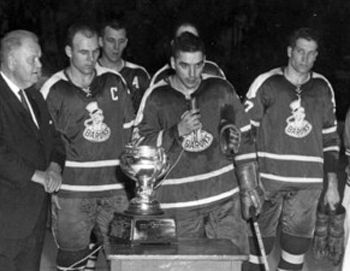
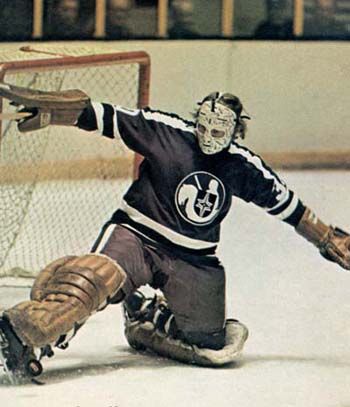


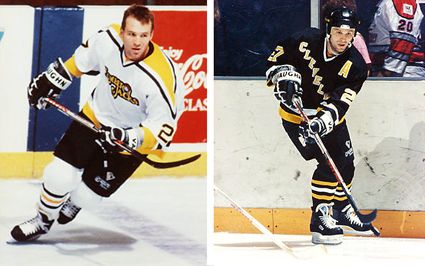
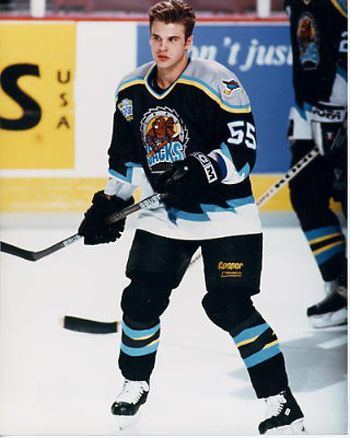

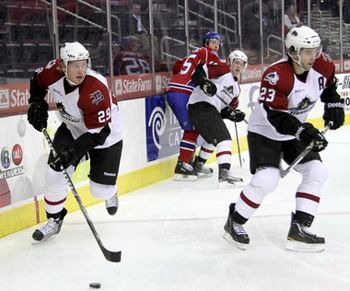
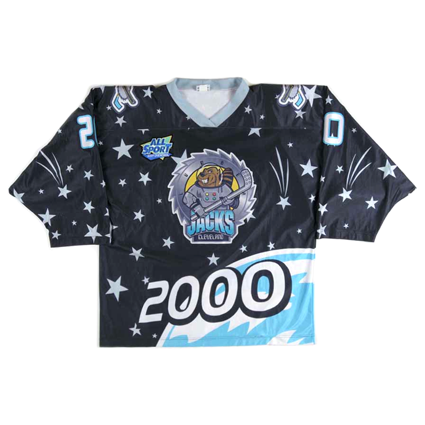
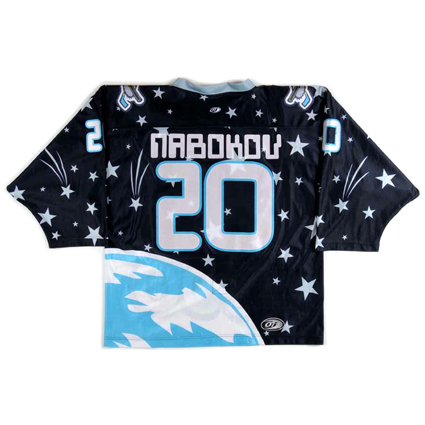
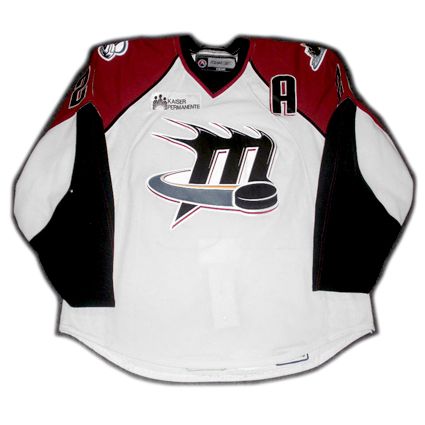
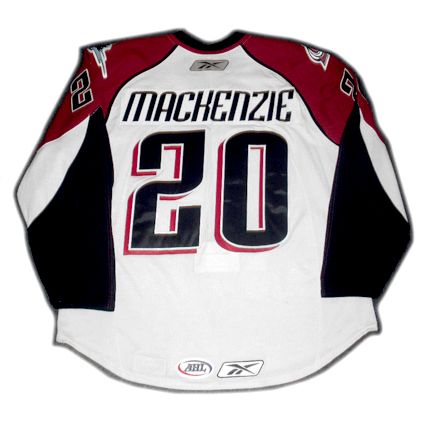










No comments:
Post a Comment
We welcome and encourage genuine comments and corrections from our readers. Please no spam. It will not be approved and never seen.